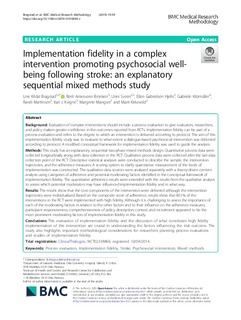| dc.contributor.author | Bragstad, Line Kildal | |
| dc.contributor.author | Bronken, Berit Arnesveen | |
| dc.contributor.author | Sveen, Unni | |
| dc.contributor.author | Hjelle, Ellen Gabrielsen | |
| dc.contributor.author | Kitzmüller, Gabriele | |
| dc.contributor.author | Martinsen, Randi | |
| dc.contributor.author | Kvigne, Kari Johanne | |
| dc.contributor.author | Mangset, Margrete | |
| dc.contributor.author | Kirkevold, Marit | |
| dc.date.accessioned | 2019-03-18T07:34:53Z | |
| dc.date.available | 2019-03-18T07:34:53Z | |
| dc.date.created | 2019-03-15T23:01:27Z | |
| dc.date.issued | 2019 | |
| dc.identifier.citation | BMC Medical Research Methodology. 2019, 19 (59), . | nb_NO |
| dc.identifier.issn | 1471-2288 | |
| dc.identifier.uri | http://hdl.handle.net/11250/2590358 | |
| dc.description.abstract | Background
Evaluation of complex interventions should include a process evaluation to give evaluators, researchers, and policy makers greater confidence in the outcomes reported from RCTs. Implementation fidelity can be part of a process evaluation and refers to the degree to which an intervention is delivered according to protocol. The aim of this implementation fidelity study was to evaluate to what extent a dialogue-based psychosocial intervention was delivered according to protocol. A modified conceptual framework for implementation fidelity was used to guide the analysis.
Methods
This study has an explanatory, sequential two-phase mixed methods design. Quantitative process data were collected longitudinally along with data collection in the RCT. Qualitative process data were collected after the last data collection point of the RCT. Descriptive statistical analyses were conducted to describe the sample, the intervention trajectories, and the adherence measures. A scoring system to clarify quantitative measurement of the levels of implementation was constructed. The qualitative data sources were analyzed separately with a theory-driven content analysis using categories of adherence and potential moderating factors identified in the conceptual framework of implementation fidelity. The quantitative adherence results were extended with the results from the qualitative analysis to assess which potential moderators may have influenced implementation fidelity and in what way.
Results
The results show that the core components of the intervention were delivered although the intervention trajectories were individualized. Based on the composite score of adherence, results show that 80.1% of the interventions in the RCT were implemented with high fidelity. Although it is challenging to assess the importance of each of the moderating factors in relation to the other factors and to their influence on the adherence measures, participant responsiveness, comprehensiveness of policy description, context, and recruitment appeared to be the most prominent moderating factors of implementation fidelity in this study. | nb_NO |
| dc.language.iso | eng | nb_NO |
| dc.publisher | BioMed Central | nb_NO |
| dc.rights | Navngivelse 4.0 Internasjonal | * |
| dc.rights.uri | http://creativecommons.org/licenses/by/4.0/deed.no | * |
| dc.title | Implementation fidelity in a complex intervention promoting psychosocial well-being following stroke: an explanatory sequential mixed methods study | nb_NO |
| dc.type | Journal article | nb_NO |
| dc.type | Peer reviewed | nb_NO |
| dc.description.version | publishedVersion | nb_NO |
| dc.source.pagenumber | 18 | nb_NO |
| dc.source.volume | 19 | nb_NO |
| dc.source.journal | BMC Medical Research Methodology | nb_NO |
| dc.source.issue | 59 | nb_NO |
| dc.identifier.doi | https://doi.org/10.1186/s12874-019-0694-z | |
| dc.identifier.cristin | 1685276 | |
| dc.description.localcode | © The Author(s). 2019. Open Access. This article is distributed under the terms of the Creative Commons Attribution 4.0 International License (http://creativecommons.org/licenses/by/4.0/), which permits unrestricted use, distribution, and reproduction in any medium, provided you give appropriate credit to the original author(s) and the source, provide a link to the Creative Commons license, and indicate if changes were made. | nb_NO |
| cristin.unitcode | 194,65,70,0 | |
| cristin.unitname | Institutt for helsevitenskap Gjøvik | |
| cristin.ispublished | true | |
| cristin.fulltext | original | |
| cristin.qualitycode | 1 | |

